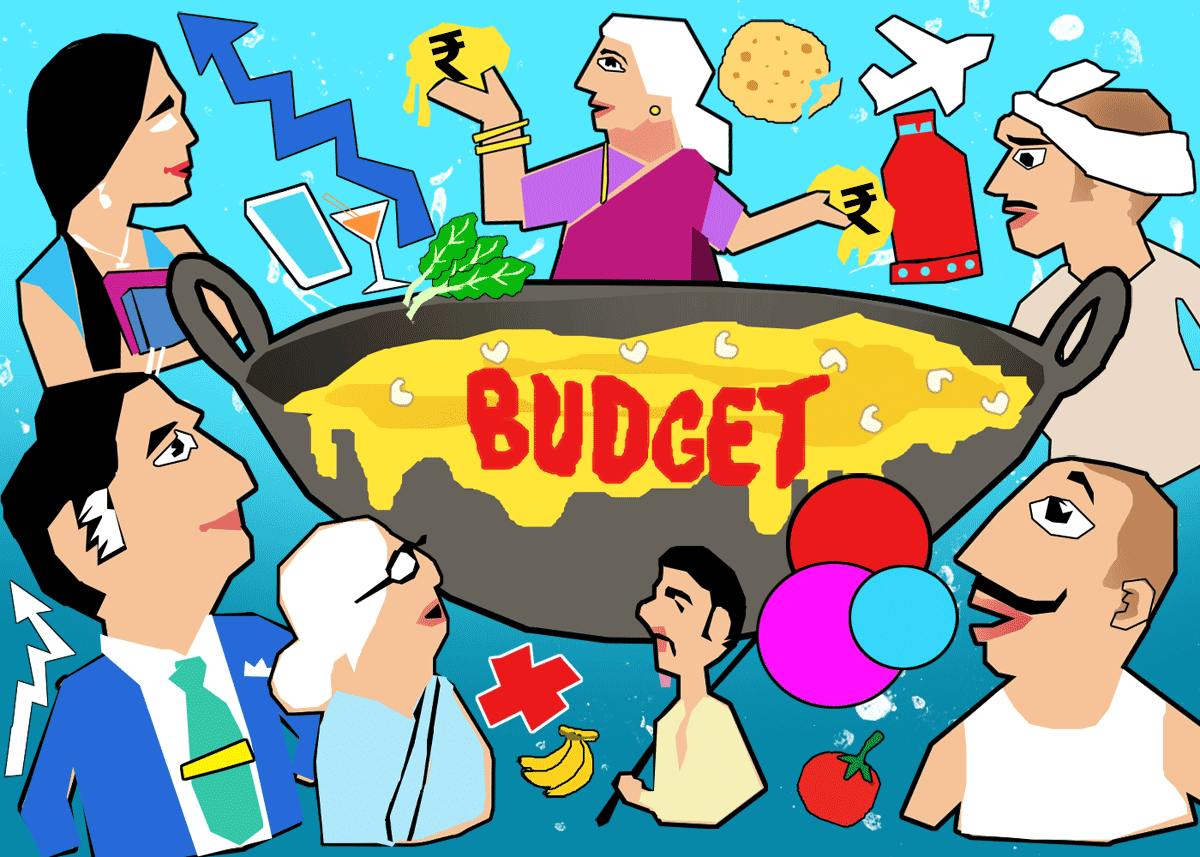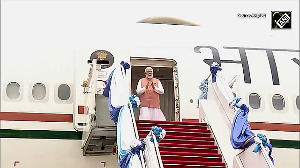'We have essentially tried to set out an agenda for the next five years and it, in essence, represents the political commitment to that agenda.'

Finance Secretary T V Somanathan had a wide-ranging discussion with A K Bhattacharya, editorial director, Business Standard, at the Budget with BS: The Fine Print event in Mumbai on Wednesday, July 31, 2024.
On the Budget vision
The Budget has tried to mix two things. One, continue what is good, and two, start more good things, if I put things very simplistically.
So, in terms of fiscal consolidation, it signals continuity where it's important, especially in a changed political context.
But there is a clear message of continued emphasis on macroeconomic stability. That includes the path of fiscal consolidation outlined several years ago.
The change part comes in a big focus on employment as a challenge for us to meet over the next five years.
So, it's a big emphasis on employment and also, a number of new initiatives that will take this country forward in terms of a higher sustainable long-term growth rate (along with) structural measures in a series of areas... We have essentially tried to set out an agenda for the next five years and it, in essence, represents the political commitment to that agenda.
On job creation numbers
This is one of the most important and yet most challenging part of what this Budget has tried to do and I admit (that) this is not an easy thing to do.... We have decided to take the plunge.
This is something the PM was very keen on, doing something very concrete at scale, to push employment-intensity of growth. This is a response to that clear policy direction.
Our conversations with manpower, agencies, industries do indicate that the government can neutralise some of the handicaps through fiscal incentives which don't require 28 states to agree.
We want Indian style of polity and Chinese style (of) growth. These are some of the things we have to sort of experiment with.
On tax incentives
There is a problem with tax incentives. When you have relatively lower corporate taxes and companies which can incur losses for years, the discounted present value of what you give as a tax benefit is often much delayed.
Also, we are distinctly moving in the direction of simplifying the tax code and tax incentives create compliance problems. So, I don't think there is a big difference there.
It is not going to be very bureaucratic. It is intended to be very simple.
The reference to the EPFO is because we need a measurement mechanism which is above board... We will work on the details but I think the fact that it is a subsidy and not a tax benefit is not, per se, a disadvantage.
On monitoring the internship scheme
The underlying idea is that we have a problem in terms of the levels of skills of the people coming out of many of our educational institutions. They don't have the skills which make them readily employable by industry.
The silver lining is that we also seem to have a problem where industry says I can't find people to give jobs to.
It's a complicated attempt to address it but it is a complicated problem.... For the private sector, the entire amount comes only from CSR expenditure.
We have looked at the numbers. Around Rs 26,000 crore (Rs 260 billion) was spent last year on CSR by approximately 20,000 companies in India. Often, the money was spent on good things but those are the good things that the government also does.
What we are suggesting to them is to take a part of your CSR, let's say 40 per cent of what you do, and devote it to skilling.
On upgrading industrial training institutes (ITIs)
This is not the first time the government is embarking on upgrading ITIs. We have tried to learn lessons from two earlier centrally sponsored schemes.
One of the things which we found is there is a lot of technological change which makes the skills out of date... so you have to update for technology.
It is very capital-intensive to do it in all ITIs. That is why we are now talking about the hub-and-spoke model.
We will need active collaboration with the states and some collaboration with the industry.... We are clear that this will be rolled out only where the state government is committed to achieving these quality objectives.
On fiscal consolidation road map
We have a clear deficit path until 2025-2026 which was committed to in February 2021, which is below 4.5 per cent in 2025-2026 and it has been reiterated in this year's Budget.
What we intend to do is to have in the future a path towards a reduction in the ratio of central government debt-to-GDP. It's not the level of debt that matters as much as the trajectory of your debt-to-GDP.
Today, we are at about 58.2 per cent for 2023-2024 on the basis of provisional actuals. So, we have a choice between a theoretically beautiful number which nobody follows or a more flexible number that the government actually follows.
In the last four years, we have had that flexible number which was actually followed.
We don't want to over-commit... We want to see a declining debt-to-GDP path and to achieve that decline, we will need to set the deficit at some level sub-4.5 per cent, but not necessarily 3 per cent.
On expenditure challenges, food subsidies
Food subsidies have not declined because of any efficiency improvement. It has declined because last year numbers had risen by arrear payments for decentralised procurement done by various states for which Bills had been pending.
On India's subsidy challenge
It has not gone away. Nothing has structurally changed on either the food or the fertiliser subsidy.
There has been a major structural improvement on petroleum subsidies in the last 10 years. We used to have big subsidies on kerosene and diesel, it is zero now.
We have a subsidy now only for cooking gas to Ujjwala customers who are acknowledged to be poor. Government deserves a lot of credit for almost eliminating the petroleum subsidies.
On the unchanged outlays for PM-KISAN
Amount of income transfers have remained the same but from farmer's point of view, input costs have not changed and MSPs are rising. So, I don't think there is a significant justification there because costs for farmers are unchanged.
On lowering the defence budget
In nominal terms, there is no reduction. It is Rs 21,000 crore (Rs 210 billion). They are spread over four different demands and there is some rejigging of the demands for capital outlays.
We used to have separate demands for the army, navy, air force, they have been grouped into one. So, the nominal amount has barely changed, it is almost flat.
Since the overall expenditure has increased, it may be declining as a percentage of the total.
That is not a reflection of any reduction in the attempts or efforts on defence. It is what they have said they require for this year, given that their procurement cycles are very long.
There have also been some delays in procuring equipment from certain countries, which means payments are delayed. That reflects in some of the cash budgets we have. But there is no de-emphasis on budget whatsoever.
On widening the tax base
Various steps that have been taken over a period of time on tax collection at source, tax deduction at source, they have been quite successful.
We have grown from about 30 million taxpayers a decade ago to about 82 million taxpayers now. I am talking about personal income tax.
The steps that we have taken are producing results.... We have people who are filing returns, particularly professional people such as lawyers, doctors, but the incomes we believe are under-reported.
Again, not all. There are ethical people in these professions.
On review of capital gains indexation
It is not necessarily true that the removal of indexation is causing a loss. The rate of tax has come down to 12.5 per cent from 20 per cent.
Depending on the compound rates of the growth of the asset, this may be beneficial or harmful. In many cases, it is beneficial.
On Customs duty review
Atmanirbharta continues to be the guiding principle. One of the reductions is on mobile, where it has gone down to 15 per cent from 20 per cent.
As part of the phased manufacturing programme 2018, it was raised earlier.... I think it is consistent with the policy of encouraging domestic manufacturing in areas where we have a short-term comparative disadvantage.
On the trend reversal in non-tax revenue
We treat the RBI dividend as a one-off, and that is why we have not started any big expenditure programme.... Now, what will happen in the future, I am not clear, but the non-RBI part is sustainable, and I think it will grow at least at the rate of the nominal GDP.
On the change in emphasis on disinvestment?
We are emphasising on a value-creation strategy. But that does not mean there will be no privatisation.
On Census
The Budget provision is made as requested by the department that is conducting the Census. If more money is required, that will be provided. The Budget is not a constraint for conducting a Census.
On market borrowings
In absolute numbers, it may never go back to the pre-pandemic level because the economy has become much bigger.
The nominal size of the economy has expanded. We are getting close to the level of the lower deficit that we had.
On reform of the national economy framework
It is intended to be a document that will set out the government's approach. It will be a consultative document which takes states and the private sector into consultation.
There are a number of structural issues that we need to rethink about in the light of where India wants to be in 2047.
Feature Presentation: Ashish Narsale/Rediff.com












 © 2025
© 2025